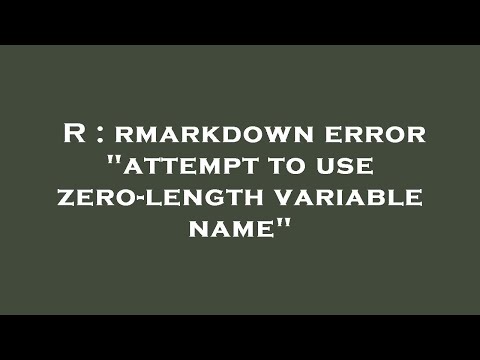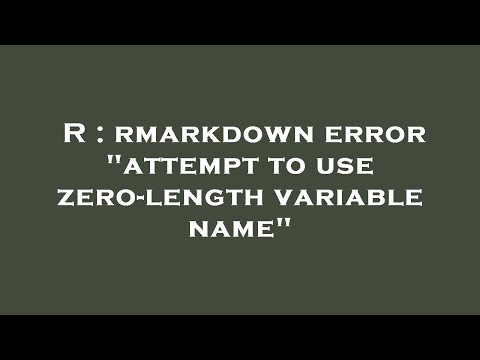Error: Attempt To Use Zero-Length Variable Name
In R programming, one common error that programmers encounter is the “Error: attempt to use zero-length variable name”. This error occurs when a variable is defined with a name of zero length or when an attempt is made to use such a variable. In this article, we will discuss this error in detail, including its common causes and how to resolve it. We will also touch upon the related error “Error: attempt to apply non function” and provide guidance on using R Markdown effectively.
Common Causes of the Error:
1. Assigning an empty value to a variable name: One of the causes of this error is when a variable is assigned an empty value. For example, if you write `var <- ""` or `var <- ''`, you will encounter the "Error: attempt to use zero-length variable name". To avoid this, make sure to assign a meaningful value to the variable.
2. Forgetting to give a variable a name before using it: Another cause of this error is when you forget to give a variable a name before using it. For instance, if you write `<- c(1, 2, 3)`, you will encounter this error. To fix this, ensure that you provide a valid name for the variable.
3. Mistakenly using double quotation marks for variable declaration: This error can also occur if you mistakenly use double quotation marks instead of the assignment operator `<-` for variable declaration. For example, if you write `"var" <- 5` instead of `var <- 5`, you will encounter this error. Remember to use `<-` for variable assignments in R.
4. Errors in referencing variables within the code: Sometimes, this error arises due to mistakes in referencing variables within the code. For instance, if you mistakenly reference a variable that does not exist, you will encounter this error. To resolve this, double-check the variable names and ensure they are correctly referenced.
5. Incorrect syntax while defining variables: Using incorrect syntax while defining variables can also lead to this error. For example, if you write `var = 10` instead of `var <- 10` or `var <- 'a'` instead of `var <- "a"`, it can cause this error. Use the appropriate syntax for variable declaration and assignment.
6. Issues with scoping and visibility of variables: Problems related to scoping and visibility of variables can also result in the "Error: attempt to use zero-length variable name". This can occur when you try to access a variable that is not in the current scope or is not visible. Ensure that the variables are declared and accessible within the appropriate scope.
Now, let's address the related error "Error: attempt to apply non function" and provide guidance on using R Markdown effectively.
Error: Attempt to Apply Non-Function:
The error "Error: attempt to apply non function" occurs when you try to call a variable or an object as a function. This often happens when the intended function name is mistakenly assigned to a variable. To fix this error, carefully review your code and ensure that the objects and variables are used appropriately according to their intended purpose.
How to Use R Markdown Error: Attempt to Use Zero-Length Variable Name:
To avoid encountering these errors, it is crucial to follow certain best practices when working with R programming and R Markdown. Here are a few tips to help you use R Markdown effectively and reduce the occurrence of the "Error: attempt to use zero-length variable name":
1. Double-check variable names: Always verify the variable names used in your code. Ensure that the names are spelled correctly and are assigned meaningful values. Avoid using zero-length variable names or variables with reserved keywords.
2. Use proper syntax: Follow the correct syntax for variable declaration and assignment. Use the assignment operator `<-` rather than double quotation marks for assigning values to variables.
3. Test and debug your code: Regularly test and debug your code to identify any errors early on. Use tools such as the R console or debugging packages to pinpoint and resolve issues related to zero-length variable names or applying non-functions.
4. Clearly define the purpose of variables: Clearly define the purpose and scope of each variable in your code. This will help you avoid referencing non-existent or inaccessible variables.
5. Learn from online resources and examples: Make use of online resources, tutorials, and examples to enhance your understanding of R programming and R Markdown. This will help you gain better insight into best practices and avoid common errors.
FAQs (Frequently Asked Questions):
Q1. Can I use single quotation marks for variable declaration in R?
A1. No, in R programming, it is preferred to use the assignment operator `<-` for variable declaration and assignment. Using single and double quotation marks to declare variables can lead to the "Error: attempt to use zero-length variable name".
Q2. How can I fix the "Error: attempt to apply non function" in R?
A2. To fix the "Error: attempt to apply non function," carefully review your code and ensure that you are using variables and objects appropriately. Double-check that the intended function names are not mistakenly assigned to variables.
Q3. Are there any debugging tools or packages available for R programming?
A3. Yes, there are several debugging tools and packages available for R programming. Some popular ones include `debug`, `debugonce`, and `browser`. These tools can help you identify and resolve errors related to zero-length variable names or applying non-functions.
In conclusion, the "Error: attempt to use zero-length variable name" can be caused by various factors, such as assigning an empty value, forgetting to name a variable, or using incorrect syntax. Following best practices, such as checking variable names, using proper syntax, and thoroughly testing your code, can help prevent encountering this error. Additionally, being aware of related errors like "Error: attempt to apply non function" and utilizing appropriate debugging tools will aid in a smoother coding experience in R.
R : Rmarkdown Error \”Attempt To Use Zero-Length Variable Name\”
Keywords searched by users: error: attempt to use zero-length variable name Error: attempt to apply non function, How to use R Markdown
Categories: Top 17 Error: Attempt To Use Zero-Length Variable Name
See more here: nhanvietluanvan.com
Error: Attempt To Apply Non Function
While programming is often a rewarding and fascinating field, it can also be frustrating and challenging at times. One of the common errors that programmers come across is the “Error: Attempt to Apply Non-Function.” This error message is displayed when a non-function value is used as if it were a function in the code. This article will delve into this error, discussing its causes, potential solutions, and how to avoid it in future programming endeavors.
Understanding the Error:
The “Error: Attempt to Apply Non-Function” occurs when a programmer tries to call a non-function value as if it were a function. In simpler terms, it means that the program is attempting to execute a non-function object, such as a variable or an incorrect reference, as a function. This mistake leads to the error being thrown, preventing the program from executing successfully.
Causes of the Error:
There are several reasons why this error may occur. One of the common causes is a typographical error, where a variable or a reference is mistakenly used as a function. Another reason might be that the programmer assumed a specific object would behave like a function, but it doesn’t. Additionally, if a value is incorrectly assigned to a variable, such as assigning a non-function value to a variable that should contain a function, this error may arise.
Solutions to Fix the Error:
To fix the “Error: Attempt to Apply Non-Function,” it is crucial to identify the source of the problem. Here are a few steps that can assist in resolving this error:
1. Check for typographical errors: Carefully review the code for any misspelled function names or incorrect references to functions.
2. Verify object types: Ensure that the correct object types are being used as function values. Double-check variable assignments to confirm that they hold expected function values.
3. Debugging: Use debugging tools integrated into the development environment or employ print statements to identify the source of the error. Inspect values and object types during runtime to identify mismatches.
4. Follow best practices: Adhere to best coding practices to minimize the possibility of encountering this error. Use consistent naming conventions, properly initialize variables, and maintain a clean code structure.
Avoiding the Error in Future:
Prevention is always better than cure. Here are some practices to follow to minimize the chances of encountering the “Error: Attempt to Apply Non-Function”:
1. Code review: Always have someone else review your code. A fresh pair of eyes can often spot mistakes that may lead to this error.
2. Consistent naming conventions: Use descriptive and consistent naming conventions for variables, functions, and objects to reduce the likelihood of confusion or typos.
3. Type-checking: Utilize type-checking mechanisms provided by the programming language. Explicitly declare function types and utilize compile-time checks if available.
4. Test-driven development (TDD): Adopt TDD principles to write tests before implementing functions. This approach helps detect incorrect assignments and verifies that functions behave as expected.
5. Documentation: Document your code properly, including comments that explain the purpose and expected types of functions and variables. This helps you and others understand the code and prevents misuse.
FAQs:
1. What is a non-function value?
In programming, a non-function value refers to any value that is not a function object. This can include variables, incorrect references, or objects of different types.
2. Why does the “Error: Attempt to Apply Non-Function” occur?
This error occurs when a non-function value is used as if it were a function. The program tries to execute an object that is not a function, leading to the error being thrown.
3. How to fix the “Error: Attempt to Apply Non-Function” message?
To fix this error, carefully review the code for typographical errors, verify object types being used as functions, and use debugging tools to identify and fix the problem.
4. How can I prevent encountering this error in the future?
To prevent this error, code reviews, consistent naming conventions, type-checking, TDD practices, and proper documentation can be implemented.
In conclusion, the “Error: Attempt to Apply Non-Function” can be a common stumbling block for programmers. By understanding its causes, implementing the appropriate solutions, and following good coding practices, programmers can minimize encounters with this error. Remember, prevention is key, and staying vigilant can ensure smoother programming experiences.
How To Use R Markdown
In the world of data analysis and reporting, efficiency and reproducibility are key. Researchers, data scientists, and analysts require a tool that not only facilitates the process but also ensures the reports are easily shared and reproduced. This is where R Markdown comes into play. In this article, we will explore R Markdown, its capabilities, and how to effectively use it for data analysis and reporting.
What is R Markdown?
R Markdown is an open-source framework that combines the formatting power of Markdown with the computational capabilities of R. Markdown is a simple plain text formatting syntax that enables the creation of documents in various formats, such as HTML, PDF, and Microsoft Word, while R allows for statistical computing and graphics. With this combination, R Markdown simplifies the process of integrating code, results, and visualizations into a structured document, making it ideal for data analysis and reporting.
Getting Started with R Markdown
To begin using R Markdown, you first need to have R and RStudio installed on your machine. R is a programming language widely used for statistical computing and graphics, while RStudio is an integrated development environment (IDE) for R. Both R and RStudio are open-source and can be easily downloaded from their respective websites.
Once you have R and RStudio installed, you can create an R Markdown document by selecting “File” and then “New File” in RStudio, followed by “R Markdown.” This will generate a template with some basic code and formatting options. You can choose the output format, specify the title, author, and date, and even include a brief abstract.
Combining Text and Code
One of the core features of R Markdown is the ability to blend text, code, and output seamlessly. You can write plain text paragraphs using Markdown syntax, create headings and subheadings, and format the text as needed. Additionally, you can include chunks of R code by enclosing them in backticks, like `this`.
To execute the code chunks, you simply click the “Knit” button in RStudio, which will run the code and generate the document output according to the specified format. This allows you to not only document your analysis but also automate the reporting process.
Generating Visualizations
R Markdown enables the inclusion of visualizations directly into the document. After executing an R code chunk that generates a plot, the resulting graph can be embedded in the report. This seamless integration of code and visualizations eliminates the need for manual copying and pasting from external software, ensuring reproducibility.
Controlling Document Appearance
R Markdown allows for fine-grained control over the appearance of the generated document. Styles such as font type, size, and color can be customized using CSS, while the layout, pagination, and table of contents can be adjusted through YAML metadata. These features give you the flexibility to create visually appealing and professional-looking reports.
Frequently Asked Questions
Q1: Can I include mathematical equations in R Markdown?
Yes, you can include mathematical equations using LaTeX syntax in R Markdown. LaTeX is a widely used typesetting system for mathematical and scientific documents. By enclosing the mathematical expression in dollar signs, like `$E=mc^2$`, R Markdown will render it as an equation.
Q2: Can I import data from external sources into R Markdown?
Absolutely! R Markdown supports importing data from various sources such as CSV, Excel, or databases. You can use R packages like `readr` or `xlsx` to read the data into R, and then manipulate it and include it in your document using code chunks.
Q3: Can I collaborate with others on an R Markdown document?
Yes, you can collaborate with others on an R Markdown document using version control systems like Git or file sharing platforms. R Markdown documents are plain text files, making them ideal for collaboration and version tracking.
Q4: Can I customize the document output format?
R Markdown provides a wide range of output formats, including HTML, PDF, Microsoft Word, and even presentations. You can select the output format through the YAML metadata or use additional packages to create custom formats.
Q5: Can I publish my R Markdown documents online?
Yes, R Markdown documents can be easily published online. Platforms like GitHub, Rpubs, and WordPress support the rendering of R Markdown documents, making them accessible to a broader audience.
In conclusion, R Markdown is a powerful tool that simplifies the process of data analysis and reporting by seamlessly integrating text, code, and visualizations. By following the steps outlined in this article, you can harness the capabilities of R Markdown to create reproducible, visually appealing, and shareable documents for all your data analysis needs. So, give it a try and unlock the potential of R Markdown in your work today!
Images related to the topic error: attempt to use zero-length variable name

Found 36 images related to error: attempt to use zero-length variable name theme












Article link: error: attempt to use zero-length variable name.
Learn more about the topic error: attempt to use zero-length variable name.
- Chapter 3 R & RStudio, RMarkdown | R for Excel Users
- Fixing the R Error: attempt to use zero-length variable name
- rmarkdown error “attempt to use zero-length variable name”
- Fix: Error: Attempt to use zero-length variable name
- Error : attempt to use zero-length variable name : r/rstats – Reddit
- rename() and error – attempt to use zero-length variable name …
See more: https://nhanvietluanvan.com/luat-hoc/